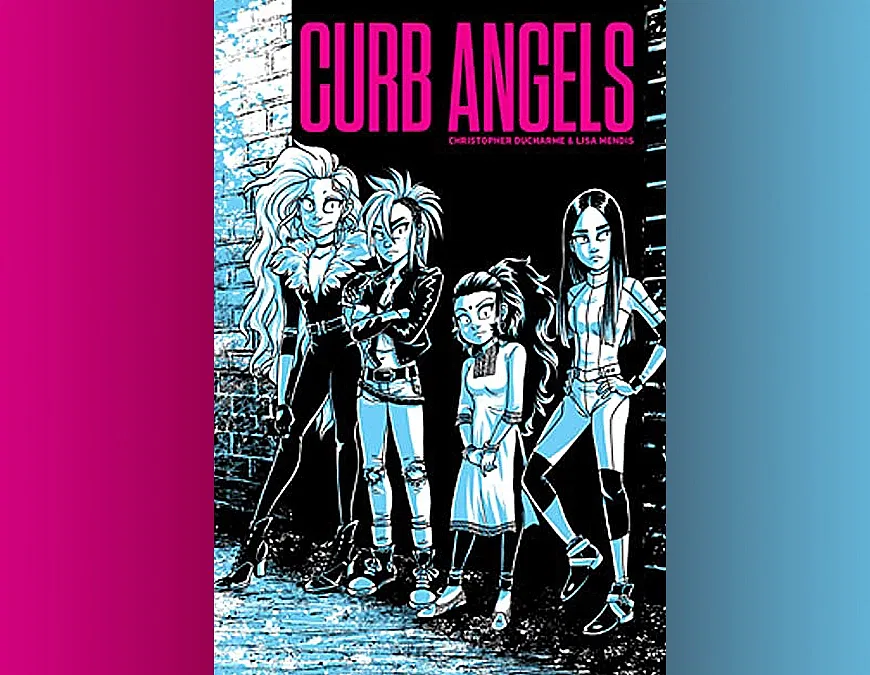
Kat, a mohawked Scot, travels to Thailand at the request of a mysterious letter found in her belongings signed by the anonymous ‘W’. Arriving at the Buddha statue rendezvous point, she meets the gregarious and petite Jula as well as the terse and fierce Reiko, both of whom arrived at this spot under the same circumstances. The letter promised a large sum of cash upon their arrival, and eventually their benefactor appears, a wild blonde with a wilder grin who calls herself Waffles. Waffles leads them to a brothel and begins selecting trafficked women from the lineup, much to the dismay of her mercenaries, before assaulting the male brothel staff in a controlled fury. Instructing the three other women to join in, Waffles reveals herself to be the leader of an organization that frees trafficked women from bondage and lodges them at a safe location known as Compassion House.
Curb Angels has a plot that would fit in with B-movies from the 80s such as Panther Squad, with a group of attractive women combining forces to defeat mob bosses and thugs with violence. Curb Angels manages to avoid being as sleazy as something like Panther Squad by not treating the lead characters in an exploitative way. Wise, considering they are directly fighting sex traffickers. That being said I was left with questions about how tasteful a fun action romp like this is when the backdrop behind it all involves the most unspeakable exploitation of all.
But first, let me talk about how the book looks, which is pretty dang stylish. The art is excellently penned and even minor backgrounders have designs that allow you to peg what kind of person they are right on sight. I was amused by one sight gag where some Thai kids are mockingly gesturing at Kat that she is a ‘round eye’ by lifting their eyelids, despite that this book has an anime inspired style where everyone has big eyes. The fact that the main characters are being led to a brothel in the opening segment is also foreshadowed by a dude in a fedora having two women hanging off of him in the background, as the girls were clearly paid to do such a thing for this proto-Reddit guy.
The colors consist of washes of either cyan or magenta. Two of the primary colors for printing, and the two bubblegum colors now associated with post-Suicide Squad Harley Quinn, which I guess now is an appropriate color scheme for fictional femme-fatales as a whole. Frequently an entire object or fore/background is given one of the colors, or there is no color at all. Opening scenes feature Kat with either no wash fill or a magenta wash fill against a cyan Thailand in the background. Different combinations of the limited pallet show their stuff throughout the book, accenting some action scenes in ways I didn’t see coming.

The limited color palette on a first read, and likely subsequent ones, does not come across as some thematically relevant decision. It is simply a very neat looking style. A graphic novel that makes incredible thematic and structural use of its limited CMYK color palette is Asterios Polyp, where each color means something or is only seen during certain periods of its timeline. Curb Angels is unfortunately not as thought out, and due to the limited number of pages it has (only 128), it is not fully capable of addressing the underbelly of its subject matter, on account of its length and its genre.
The sex trafficking industry is the central antagonist of the book, and Curb Angels aims to be a brief revenge fantasy opposing it. Three of the four-woman gang are capable combatants, serving as cathartic avengers, while the rescued women are frequently relegated to the sidelines. The character Reiko is more complicated, as she was a victim who escaped and committed herself to learning self-defense for her benefit and others. With the exception of Reiko, the victims of the sex trafficking do not have much to say and are largely an accessory to the action plot. This is mostly on account of the genre, as conflict in an action story should be solved with action. This being an action genre book, I had to shove aside questions about how the rescued victims were going to handle their trauma or why they had very little to do besides be rescued. Not every story has the depth to handle this, and whatever enjoyment Curb Angels can bring with its flashy style can be taken at face value. Mostly because the main characters basically admit that they are at a loss for how to handle the larger issue.
So that’s about where I would come down on Curb Angels, a distinct looking book that doesn’t have the length to provide the depth I would have wanted. Even the setting of 1984 does not seem particularly inspired and is just a tertiary detail. The year choice if little baffling considering sex tourism is just as rampant in Thailand today, and a modern day setting would have made just a much sense. But sometimes, you just need something that looks and feels good that’s executed without any major tumbles or mistakes.

Curb Angels was created by a multi-member team. Lisa Mendis and Christopher Ducharme headed the writing and artwork. Design and layouts were handled by M.C. Joudrey and Lucas c Pauls. It was published in 2019 by At Bay Press and can be purchased on their website as a print copy or digital pdf.




